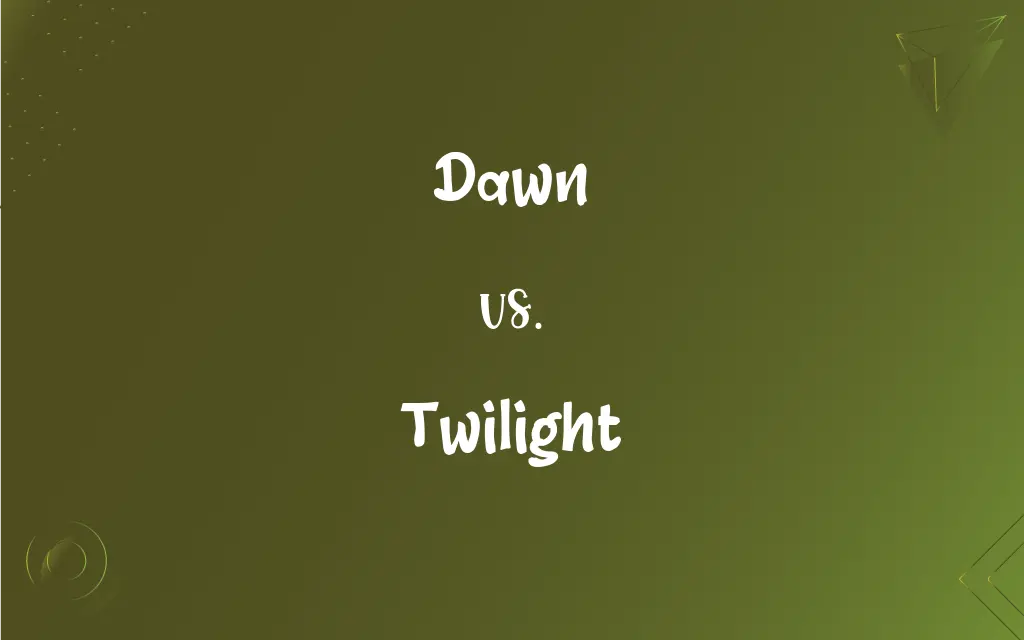Dawn vs. Twilight: What's the Difference?
Edited by Aimie Carlson || By Harlon Moss || Updated on October 20, 2023
Dawn is the period when light first appears in the sky, while twilight is the time when the sun is below the horizon but its light is still visible.

Key Differences
Dawn refers to the initial appearance of light in the sky before the sun rises. It symbolizes the start of a new day, bringing a fresh beginning. Twilight, on the other hand, is the period of dim light after sunset but before complete darkness sets in. It often conveys a sense of closure, as the day transitions to night.
Dawn and twilight, although seemingly opposite, are both transitional phases. Dawn is characterized by increasing light, signaling the morning's onset. Twilight is marked by fading light, heralding the approach of nighttime.
In literature and poetry, dawn often represents hope, rebirth, and renewal, a fresh start after a dark period. Twilight, in contrast, is frequently associated with endings, reflection, and introspection, a calm before the stillness of night.
Both dawn and twilight possess their own unique beauties. Dawn brings with it the promises of a new day, a burst of colors as the sun begins its ascent. Twilight, conversely, offers serene and often dramatic hues, a moment of tranquility as the day winds down.
While dawn is eagerly awaited by those wanting to seize the start of the day, twilight is cherished by those seeking a peaceful end to their activities, a time to relax and reflect before the darkness of night.
ADVERTISEMENT
Comparison Chart
Time of Day
Just before sunrise
After sunset, before complete darkness
Associated Feelings
Hope, renewal
Closure, introspection
Symbolism in Literature
New beginnings, fresh start
Endings, reflection
Light Intensity
Increasing light
Decreasing light
Duration
Short, varies by season/location
Short, varies by season/location
ADVERTISEMENT
Dawn and Twilight Definitions
Dawn
The beginning or emergence of something.
The dawn of the internet changed global communication.
Twilight
The soft, diffused light from the sky when the sun is below the horizon.
Twilight bathed the landscape in a gentle glow.
Dawn
To become evident or understood.
The realization dawned on him that he was lost.
Twilight
A state of obscurity or ambiguity.
The case remains in a twilight of uncertainty.
Dawn
The first appearance of light in the morning.
Birds chirp at the break of dawn.
Twilight
An intermediate, transitional state.
The artist's style was in the twilight between impressionism and realism.
Dawn
The earliest period of something.
During the dawn of civilization, communities formed around rivers.
Twilight
The period of faint light after sunset and before complete darkness.
The sky was painted in hues of pink and purple during twilight.
Dawn
A first appearance; a beginning.
Her first book marked the dawn of her writing career.
Twilight
A period or condition of decline following fullness or greatness.
The empire was in its twilight years when it began to crumble.
Dawn
The time each morning at which daylight first begins.
Twilight
The diffused light from the sky during the early evening or early morning when the sun is below the horizon and its light is refracted by the earth's atmosphere.
FAQs
What is dawn?
Dawn is the period when light first appears in the sky before the sun rises.
How is twilight different from dusk?
Twilight is the broader period after sunset, while dusk is its latter part, closer to complete darkness.
Is dawn the same worldwide?
No, the timing and duration of dawn vary based on location and season.
Can dawn and twilight be used metaphorically?
Yes, dawn can symbolize beginnings, while twilight can signify endings or decline.
Do all countries experience dawn and twilight?
While most do, regions near the poles might experience polar day or night, affecting these phenomena.
How does daylight saving time affect dawn and twilight?
It can shift the perceived times of both, making them occur earlier or later in our day.
Why are dawn and twilight important in various cultures?
They often hold symbolic meanings, marking transitions in time, and are significant in religious or cultural rituals.
Are dawn and twilight the same?
No, dawn precedes sunrise while twilight follows sunset.
Which comes first, dawn or twilight?
Dawn comes first in the morning, while twilight appears in the evening.
Can dawn also refer to the beginning of something?
Yes, dawn can symbolize the start or emergence of an event or era.
Is twilight only related to the evening?
Primarily, yes. But metaphorically, twilight can refer to a declining phase or state.
Why is dawn often associated with hope?
Dawn brings the onset of a new day, symbolizing fresh beginnings and opportunities.
Are dawn and twilight affected by the seasons?
Yes, their durations and timings can change with the seasons.
Is twilight a good time for photography?
Yes, the "golden hour" during twilight often provides soft, diffused light ideal for photography.
How can I predict the exact time of dawn?
Various apps and websites provide sunrise and dawn timings based on location.
Is there a term for the twilight before sunrise?
Yes, it's called "morning twilight."
What does twilight signify?
Twilight is the time when the sun is below the horizon but its light is still visible.
Which is longer, dawn or twilight?
Both can vary in length based on location and season, and neither consistently outlasts the other.
Which animals are active during dawn?
Many birds and some mammals, often termed "crepuscular" creatures, are active during dawn.
What feelings can twilight evoke?
Twilight often evokes feelings of reflection, closure, and tranquility.
About Author
Written by
Harlon MossHarlon is a seasoned quality moderator and accomplished content writer for Difference Wiki. An alumnus of the prestigious University of California, he earned his degree in Computer Science. Leveraging his academic background, Harlon brings a meticulous and informed perspective to his work, ensuring content accuracy and excellence.
Edited by
Aimie CarlsonAimie Carlson, holding a master's degree in English literature, is a fervent English language enthusiast. She lends her writing talents to Difference Wiki, a prominent website that specializes in comparisons, offering readers insightful analyses that both captivate and inform.































































